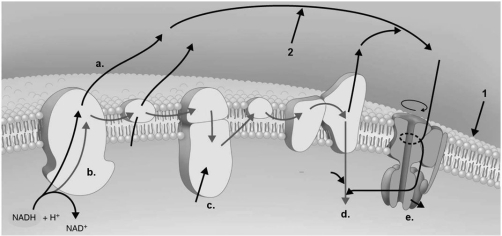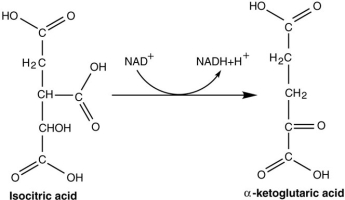A) It would bind to a.
B) It would bind to b.
C) It would bind to c.
D) It would bind to d.
E) The answer cannot be determined based on the information provided.
G) C) and E)
Correct Answer

verified
Correct Answer
verified
True/False
Glycolysis is utilized by cells in both respiration and fermentation.
B) False
Correct Answer

verified
Correct Answer
verified
Multiple Choice
Which biochemical process is NOT used during glycolysis?
A) substrate-level phosphorylation
B) beta oxidation
C) oxidation-reduction
D) carbohydrate catabolism
E) enzymatic reactions
G) A) and E)
Correct Answer

verified
B
Correct Answer
verified
Multiple Choice
The advantage of the pentose phosphate pathway is that it produces all of the following EXCEPT
A) precursors for nucleic acids.
B) precursors for the synthesis of amino acids.
C) three ATPs.
D) NADPH.
E) precursors for the synthesis of glucose.
G) B) and C)
Correct Answer

verified
Correct Answer
verified
Multiple Choice
Figure 5.8
 -Refer to Figure 5.8. In aerobic respiration, where is water formed?
-Refer to Figure 5.8. In aerobic respiration, where is water formed?
A) a
B) b
C) c
D) d
E) e
G) A) and E)
Correct Answer

verified
Correct Answer
verified
Multiple Choice
Which of the following statements are TRUE? 1- Electron carriers are located at ribosomes. 2- ATP is a common intermediate between catabolic and anabolic pathways. 3- ATP is used for the long-term storage of energy and so is often found in storage granules. 4-Anaerobic organisms are capable of generating ATP via respiration. 5-ATP can be generated by the flow of protons across protein channels.
A) 1, 2, 3
B) 1, 3, 4
C) 2, 4, 5
D) 2, 3, 5
E) All of the statements are true.
G) B) and C)
Correct Answer

verified
Correct Answer
verified
True/False
Once an enzyme has converted substrates into products, the active site reverts back to its original form.
B) False
Correct Answer

verified
True
Correct Answer
verified
Multiple Choice
Which of the following uses CO₂ for carbon and H2 for energy?
A) chemoautotroph
B) chemoheterotroph
C) photoautotroph
D) photoheterotroph
F) A) and B)
Correct Answer

verified
Correct Answer
verified
Multiple Choice
Which of the following statements regarding the glycolysis pathway is FALSE?
A) Two pyruvate molecules are generated.
B) One molecule of ATP is expended.
C) Two molecules of water are generated.
D) Four ATP molecules are generated via substrate-level phosphorylation.
E) Two NADH molecules are generated.
G) C) and D)
Correct Answer

verified
B
Correct Answer
verified
True/False
The pentose phosphate pathway can be characterized as an anabolic pathway.
B) False
Correct Answer

verified
Correct Answer
verified
Multiple Choice
Figure 5.1  Which compound is being reduced in the reaction shown in Figure 5.1?
Which compound is being reduced in the reaction shown in Figure 5.1?
A) α-ketoglutaric acid and NAD+
B) NADH and isocitric acid
C) NADH
D) isocitric acid and α-ketoglutaric acid
E) NAD+
G) C) and D)
Correct Answer

verified
Correct Answer
verified
Multiple Choice
Cyanobacteria are a type of
A) chemoautotroph.
B) chemoheterotroph.
C) photoautotroph.
D) photoheterotroph.
F) A) and C)
Correct Answer

verified
Correct Answer
verified
Multiple Choice
Which statements correspond to amphibolic pathways? 1. anabolic and catabolic reactions are joined through common intermediate 2) shared metabolic pathways 3) Feedback inhibition can help regulate rates of reactions 4) both types of reactions are necessary but do not occur simultaneously
A) 2, 3, 4
B) 1, 2, 3, 4
C) 1, 2, 3
D) 1 only
E) 2, 4
G) B) and D)
Correct Answer

verified
Correct Answer
verified
Multiple Choice
Figure 5.8
 -In Figure 5.8, the structure labeled ʺ1ʺ is
-In Figure 5.8, the structure labeled ʺ1ʺ is
A) NAD+.
B) ATP synthase.
C) cytoplasm.
D) a cell wall.
E) a plasma membrane.
G) D) and E)
Correct Answer

verified
Correct Answer
verified
True/False
In general, ATP is generated in catabolic pathways and expended in anabolic pathways.
B) False
Correct Answer

verified
Correct Answer
verified
Multiple Choice
A urease test is used to identify Mycobacterium tuberculosis because
A) M. tuberculosis produces urease.
B) some bacteria reduce nitrate ion.
C) urea accumulates during tuberculosis.
D) M. bovis can cause tuberculosis.
E) urease is a sign of tuberculosis.
G) D) and E)
Correct Answer

verified
Correct Answer
verified
Multiple Choice
Assume you are growing bacteria on a lipid medium that started at pH 7. The action of bacterial lipases should cause the pH of the medium to
A) decrease.
B) increase.
C) stay the same.
E) A) and B)
Correct Answer

verified
Correct Answer
verified
Multiple Choice
Gallionella bacteria can get energy from the reaction Fe₂+ → Fe3+. This reaction is an example of
A) the Calvin-Benson cycle.
B) reduction.
C) fermentation.
D) photophosphorylation.
E) oxidation.
G) A) and E)
Correct Answer

verified
Correct Answer
verified
Multiple Choice
In noncyclic photophosphorylation, O₂ is released from
A) H₂O.
B) sunlight.
C) C6H12O6.
D) chlorophyll.
E) CO₂.
G) A) and E)
Correct Answer

verified
Correct Answer
verified
True/False
Carbon fixation occurs during the light-independent phase of photosynthesis.
B) False
Correct Answer

verified
Correct Answer
verified
Showing 1 - 20 of 57
Related Exams